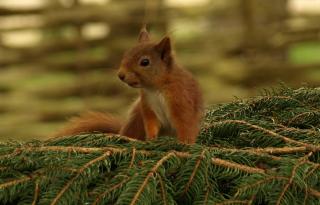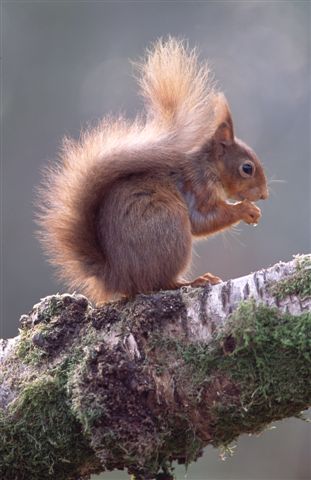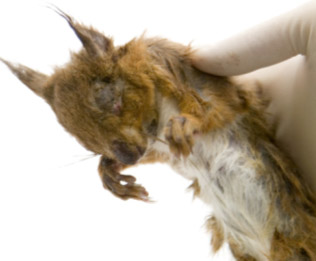The Emergence Of Squirrelpox As A Threat To Scotland's Red Squirrels
Published on 30 January 2009 in Ecosystems and biodiversity , Food, health and wellbeing

Introduction
Red squirrel numbers in the UK have been declining for the last century. The reasons for this may be many-fold, but one factor is the concomitant increase in the number of grey squirrels. The grey squirrel is not native to the UK. It was introduced, from the USA and Canada, in small numbers to various sites across the UK in the second half of the 19th century. At the time it was thought that it would pose no threat to the native red squirrel. However by 1930 it had been recognised that red squirrels were disappearing and, more often than not, being replaced by grey squirrels. Competition for woodland resources, with the greys being much more successful than the reds, was proposed as the most likely reason for this replacement. However, in addition, epidemics of disease in the red squirrels were blamed for the local extinction of some red squirrel colonies. By the late1990s it was realised that pox disease, caused by a virus now known as squirrelpox virus (SQPV), was a major contributory factor in the deaths of red squirrels across England and Wales and that the virus appeared also to infect grey squirrels, but with no obvious disease in them.
Key Points
 Monitoring of blood samples taken from both grey and red squirrels has been performed for the last 10 years. A large proportion of grey squirrels in England and Wales have been infected with the virus with no obvious affects, whereas, the vast majority of red squirrels that were infected with the virus were found dead or dying of pox disease. We have evidence that only a very small number of red squirrels are capable of surviving the disease in the wild.
Monitoring of blood samples taken from both grey and red squirrels has been performed for the last 10 years. A large proportion of grey squirrels in England and Wales have been infected with the virus with no obvious affects, whereas, the vast majority of red squirrels that were infected with the virus were found dead or dying of pox disease. We have evidence that only a very small number of red squirrels are capable of surviving the disease in the wild.
Research Undertaken
The Scottish Government, working through the auspices of Scottish Natural Heritage and Forestry Commission Scotland, published the Scottish Red Squirrel Action Plan 2006-2011. This set out a series of recommendations to help conserve the red squirrel in its current range in Scotland. As part of this plan, Moredun Research Institute is continuing to monitor blood samples from red and grey squirrels. Samples from all over Scotland are analysed to help predict the spread of the virus.
Evidence to date suggests that the resident population of Scottish grey squirrels have not previously been exposed to squirrelpox virus, but that grey squirrels carrying the virus from the south have emerged in the last few years. Research aimed at understanding more about the epidemiology of the virus and the feasibility of producing a vaccine to protect the red squirrels against the virus is also now underway.
 None of the pathological signs of disease in red squirrels are seen in infected grey squirrels. In fact no pathological changes in the grey squirrels have been detected so far. This makes understanding how the virus is transmitted between grey squirrels and from grey squirrels to red squirrels particularly difficult. Current work is thus focussed on trying to unravel what happens when a grey squirrel becomes infected with the virus and how the virus is then passed on to other squirrels.
None of the pathological signs of disease in red squirrels are seen in infected grey squirrels. In fact no pathological changes in the grey squirrels have been detected so far. This makes understanding how the virus is transmitted between grey squirrels and from grey squirrels to red squirrels particularly difficult. Current work is thus focussed on trying to unravel what happens when a grey squirrel becomes infected with the virus and how the virus is then passed on to other squirrels.
Research, funded by the Wildlife Ark Trust, has also recently started on identifying possible vaccines and vaccination strategies for squirrelpox. Poxvirus vaccines have been successfully produced in the past for a variety of diseases, but one of the biggest challenges for squirrelpox may be in delivery of the vaccine to a wild population of animals.
Policy Implications
Efforts are currently being made to restrict the virus to south west Scotland. The government are about to launch their initiative on “Saving Scotland’s Red Squirrels.” Monitoring the spread of the virus will directly influence policies of the local conservation organisations in determining where best to place efforts to control the virus. Understanding how the virus is transmitted will also help to inform on the major risk factors influencing the appearance of disease in the red squirrels.
Author
Dr Colin J. McInnes, Moredun Research Institute colin.mcinnes@moredun.ac.uk
Topics
Ecosystems and biodiversity , Food, health and wellbeing





